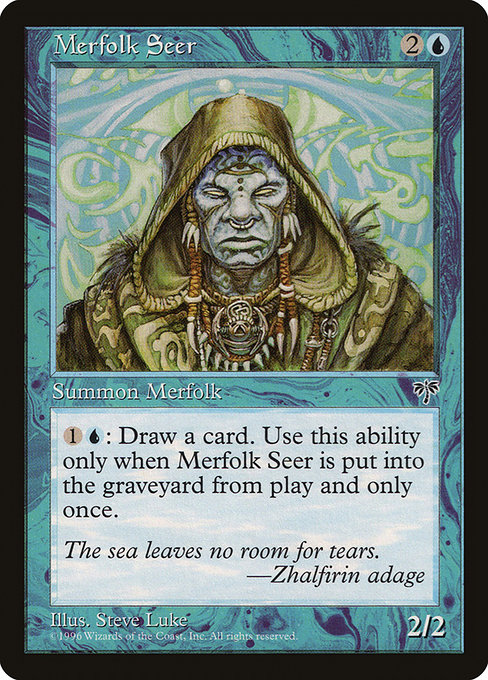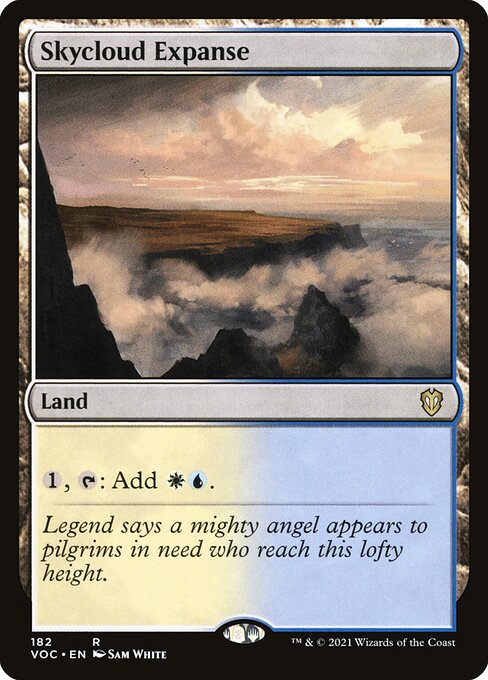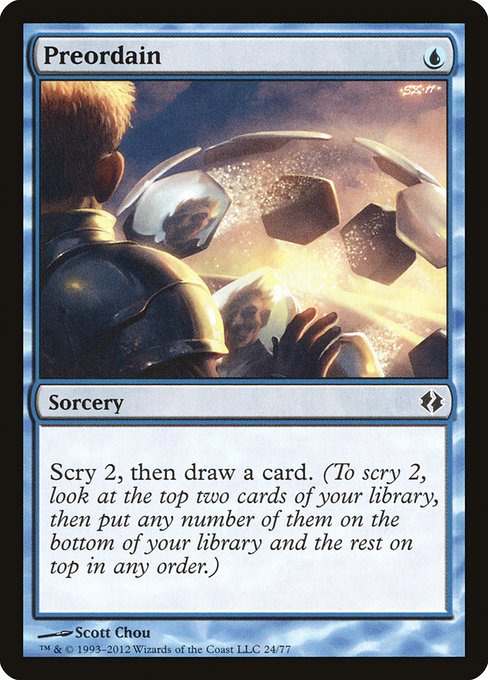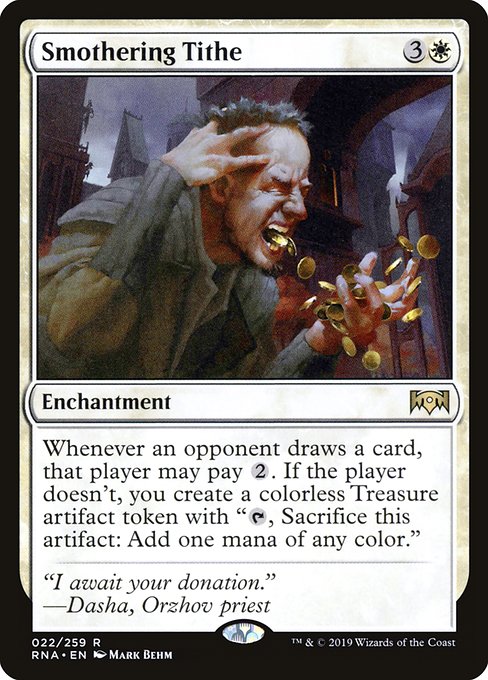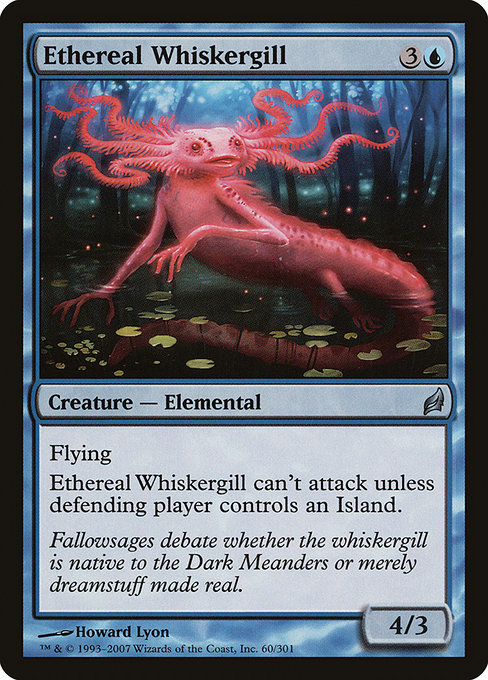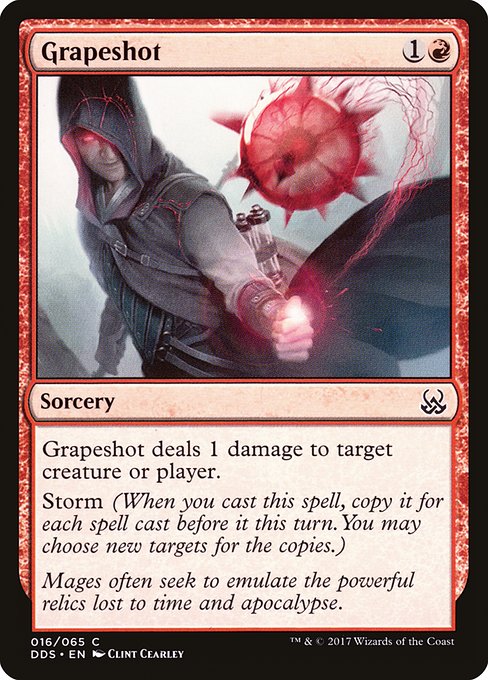
Grapeshot

Full Analysis
Generated on 2025-06-28T04:49:21.283773 • Legacy FormatGrapeshot Analysis Guide
TL;DR Summary Grapeshot is a low-toughness sorcery that deals 1 damage to any target and has Storm ability, allowing it to copy itself for each spell cast before it on the same turn. This makes Grapeshot an attractive option for aggressive decks seeking to deal early game pressure.
Detailed Card Mechanics and Interactions Grapeshot is a straightforward sorcery with two primary mechanics: its damage-dealing effect and Storm ability. The card's text box reads: "Grapeshot deals 1 damage to any target." This means that Grapeshot can be cast on itself or other creatures, planeswalkers, or even players. However, it's essential to note that the 1 damage dealt by Grapeshot is not lethal to most creatures with higher toughness.
The Storm ability states: "When you cast this spell, copy it for each spell cast before it this turn. You may choose new targets for the copies." This allows Grapeshot to create a chain of copied spells, potentially dealing significant damage to the opponent's life total or destroying valuable permanents. The key aspect of Storm is that the copied spells have their own Storm ability, enabling further copying and exponential growth.
Mechanics and Interactions
Grapeshot's mechanics are relatively simple, but its interactions with other cards can be complex. For example, when casting Grapeshot with a cantrip like Ancestral Recall, players can maintain a consistent pace of spellcasting while triggering the Storm ability repeatedly. This setup enables aggressive decks to maintain a strong early game presence while setting up for more substantial plays later in the turn sequence.
Similarly, Grapeshot pairs well with low-cost sorceries like Burning Hands, creating a chain of copied spells that deal an increasingly high amount of damage. However, it's crucial to note that the copies themselves cannot target the same permanents or players more than once per turn sequence.
Strategic Uses, Combos, and Synergies
Grapeshot excels in aggressive, combo-heavy decks seeking to deal early game pressure and swarm the board with creatures. One popular synergy involves combining Grapeshot with Burning Hands or other low-cost sorceries that deal 1 damage to any target. When cast on the same turn, these two cards create a chain of copied spells, dealing an increasingly high amount of damage.
Another strategy involves pairing Grapeshot with cantrips like Ancestral Recall, which allow players to maintain a consistent pace of spellcasting and trigger the Storm ability repeatedly. This setup enables aggressive decks to maintain a strong early game presence while setting up for more substantial plays later in the turn sequence.
Deckbuilding Roles and Archetypes
Grapeshot is primarily suited for aggro and combo decks that prioritize dealing damage quickly. It's often included in lists focused on red aggression, such as Mono-Red or Red-Green, which emphasize early game pressure and board presence.
However, Grapeshot can also be used in more controlling archetypes, like Mill or Combo, where its ability to deal 1 damage per spell cast provides additional value. In these decks, Grapeshot often serves as a secondary role, working in conjunction with more powerful spells to achieve the desired outcome.
Format Viability and Competitive Context
Grapeshot has seen play across various formats, including Modern, Pioneer, and Commander. Its Storm ability makes it a prime target for removal, but its low mana cost and versatility often justify its inclusion in aggressive decks.
In competitive environments, Grapeshot is typically considered a supporting card rather than a primary driver of strategy. Its effects are straightforward, making it less likely to be a key factor in the outcome of a match. Nevertheless, Grapeshot remains a popular choice among players seeking to create explosive combos and deal early game damage.
Rules Interactions and Technical Notes
When casting Grapeshot, the Storm ability is triggered for each spell cast before it on the same turn. This means that if multiple spells are cast simultaneously (e.g., as part of a combo), Grapeshot's Storm ability will be triggered multiple times in rapid succession.
It's essential to note that the copied spells created by Storm retain their original targets, allowing players to choose new targets for each copy. However, the copies themselves cannot target the same permanents or players more than once per turn sequence.
Art, Flavor, and Historical Context
The artwork for Grapeshot depicts a burst of flame erupting from a shattered red gemstone, evoking the idea of explosive power contained within. The card's flavor text is not explicitly stated, but its design suggests a connection to the red mana and aggressive strategies often associated with this color.
Grapeshot was first printed in Alpha (1993) as part of Magic: The Gathering's original set. Since then, it has seen several reprints across various sets, including Revised (1994), Fourth Edition (1995), and more recently, Modern Masters 2017 (2017). Throughout its history, Grapeshot has maintained its core mechanics while adapting to changing metagames and format shifts.
Strategic Considerations
When building a deck around Grapeshot, it's essential to consider the following strategic factors:
- Mana curve: Grapeshot requires minimal mana investment, making it an excellent addition to aggressive decks that prioritize early game pressure.
- Combo potential: Grapeshot excels when paired with other cards that trigger its Storm ability, creating explosive combos and dealing significant damage.
- Deck synergy: Grapeshot can be combined with various deck archetypes, from aggro to combo, depending on the desired strategy.
Key Takeaways
Grapeshot is a versatile card that offers a range of strategic possibilities. Its low mana cost, straightforward effects, and Storm ability make it an attractive option for players seeking early game pressure and explosive plays. While its role is often secondary in competitive environments, Grapeshot continues to be a staple of modern Magic: The Gathering play.
Conclusion
Grapeshot remains a beloved and powerful addition to aggressive and combo-heavy decks. Its low mana cost, straightforward effects, and Storm ability make it an attractive option for players seeking early game pressure and explosive plays. While its role is often secondary in competitive environments, Grapeshot continues to be a staple of modern Magic: The Gathering play.
Summary of Key Points
- Mechanics: Grapeshot deals 1 damage to any target and has Storm ability.
- Strategic Use: Excellent in aggressive, combo-heavy decks seeking early game pressure and board presence.
- Synergies: Combines well with Burning Hands, Ancestral Recall, and other cantrips for exponential growth.
- Deckbuilding Roles: Suited for aggro and combo archetypes; secondary role in controlling lists like Mill or Combo.
- Format Viability: Played across various formats, including Modern, Pioneer, and Commander.
- Competitive Context: Supporting card rather than primary driver of strategy.
